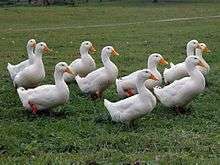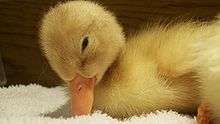American Pekin
 | |
| Conservation status | FAO (2007): not at risk[1]:153 |
|---|---|
| Other names |
|
| Country of origin | China |
| Distribution | world-wide |
| Use | meat |
| Traits | |
| Weight | |
| Egg colour | white or tinted |
| Classification | |
| APA | heavy[3] |
| EE | yes[4] |
| PCGB | no[5] |
| |

The Pekin or Peking, also White Pekin, is an American breed of domestic duck, reared principally for meat.[6][7] It derives from birds brought to the United States from China in the nineteenth century,[8] and is now bred in many countries, and in all continents.[6] It is a distinct and separate breed from the German Pekin, which derives from the same Chinese stock but has different breeding.
History
The mallard was domesticated in China before 1000 AD,[2]:92 probably much earlier.[9]:3 Force-feeding of ducks is documented from the tenth century, under the Five Dynasties.[10]:593 The Chinese were sophisticated breeders of ducks.[2]:92 Among several breeds they created was one named shi-chin-ya-tze, or roughly "ten-pound duck".[8]
In 1872, at the request of a businessman named McGrath, fifteen white ducks hatched in Peking (now called Beijing) were loaded at Shanghai by James E. Palmer of Stonington, Connecticut, for shipment to the United States. Nine birds – six ducks and three drakes – survived the voyage, which took 124 days and reached New York City on 13 March 1873.[2]:92[11] Five of the surviving birds were dispatched to McGrath, but were eaten before they reached him. Palmer's four birds became the foundation stock of the American Pekin; by July 1873, his three ducks had laid more than three hundred eggs.[12]
In 1874 the Pekin was included in the first edition of the Standard of Perfection published by the new American Poultry Association.[2]:92 It was soon in widespread production for slaughter.[2]:92 Until that time, a popular breed raised for meat had been the Cayuga, which had the disadvantage of dark feathering, so that any fluff remaining on the carcass was easily seen; the white-feathered Pekin was preferable.[12]
Other birds of the same type were imported to the United Kingdom in 1872, and from there soon reached Germany, where they gave rise to the German Pekin, a distinct and separate breed.[4][8] In Germany the Chinese ducks were cross-bred with upright white ducks brought from Japan by Dutch ships, resulting in birds with a steep body angle; those taken to the United States were crossed with birds of the British Aylesbury breed, which led to birds with a more horizontal stance.[8][13] The Pekin in the United Kingdom derives from birds imported from Germany from about 1970.[12]
Characteristics

The American Pekin is large and solidly built. The body is rectangular as seen from the side, and is held at about 40º to the horizontal; the tail projects above the line of the back.[2]:93[13] The breast is smooth and broad, and does not show a pronounced keel. The head is large and rounded, and the neck is thick. The plumage is creamy white, the legs and feet are a yellowish orange, and the beak is yellow;[14]:193 it is fairly short and almost straight.[2]:93
Use
The American Pekin is reared almost exclusively for meat. In the United States, more than half of all ducks raised for slaughter are of this breed.[2]:93 Numbers in the United States alone are in the tens of millions.[13] The birds are large-framed, hardy and fast-growing – they may reach a body-weight of more than 3.5 kg (7.7 lb) in seven weeks. They have a high feed conversion ratio, are calm-tempered and fertile, and their eggs hatch well.[2]:93 The white feathers make the carcass easy to clean.[14]:193
A number of commercial strains have been developed, including types kept solely as layers. From the time the birds reached the United States, selective breeding of meat birds was mainly directed towards size, strength and rate of growth. More recently, attempts have been made to reduce the proportion of fat in the carcass, even if growth rate and feed conversion ratio are also reduced.[2]:94
Ducks lay between 125 and 225 eggs per year.[2]:28 The eggs may be white or tinted, and weigh approximately 70 grams (2.5 oz).[13] American Pekin ducks have little tendency to broodiness – they are not good sitters, and eggs may need to be incubated.[14]:193
The American Pekin is sometimes kept for fancy and showing.[13] Show birds are often larger than commercial production stock.[2]:94
References
- ↑ Barbara Rischkowsky, D. Pilling (eds.) (2007). List of breeds documented in the Global Databank for Animal Genetic Resources, annex to The State of the World's Animal Genetic Resources for Food and Agriculture. Rome: Food and Agriculture Organization of the United Nations. ISBN 9789251057629. Accessed February 2017.
- 1 2 3 4 5 6 7 8 9 10 11 12 13 14 Dave Holderread (2011). Storey's Guide to Raising Ducks, second edition. North Adams, Massachusetts: Storey Publishing. ISBN 9781603427456.
- ↑ APA Recognized Breeds and Varieties As of January 1, 2012. American Poultry Association. Accessed February 2017.
- 1 2 Liste des races et variétés homologuée dans les pays EE (28.04.2013). Entente Européenne d’Aviculture et de Cuniculture. Archived 16 June 2013.
- ↑ Breed Classification. Poultry Club of Great Britain. Accessed August 2014.
- 1 2 Transboundary breed: Pekin. Domestic Animal Diversity Information System of the Food and Agriculture Organization of the United Nations. Accessed February 2017.
- ↑ Transboundary breed: White Pekin. Domestic Animal Diversity Information System of the Food and Agriculture Organization of the United Nations. Accessed February 2017.
- 1 2 3 4 Kenneth Broekman (December 2009). The German Pekin Duck. Aviculture Europe. 5 (6), article 12. Accessed February 2017.
- ↑ Peter Cherry, Trevor Raymond Morris (2008). Domestic Duck Production: Science and Practice. Wallingford, Oxfordshire: CABI. ISBN 9781845934415.
- ↑ Alan Davidson (1999). The Oxford Companion to Food. Oxford: Oxford University Press. ISBN 9780192115799.
- ↑ [s.n.] (February 1880). Pekin Ducks The Pet Stock Pigeon and Poultry Bulletin 10 (11): 1.
- 1 2 3 Chris Ashton, Mike Ashton (2001). The Domestic Duck. Ramsbury, Marlborough: The Crowood Press. ISBN 9781847979704.
- 1 2 3 4 5 Paul-Erwin Oswald (2004). Amerikanische Pekingenten – Entenrasse im Blickfeld 2004 (in German). Sonderverein der Entenzüchter Deutschlands von 1895. Accessed April 2017.
- 1 2 3 Carol Ekarius (2007). Storey's Illustrated Guide to Poultry Breeds. North Adams, MA: Storey Publishing. ISBN 9781580176682.
-
 Media related to American Pekin at Wikimedia Commons
Media related to American Pekin at Wikimedia Commons